Cookbooks serve as the primary inspiration for both amateur and professional pastry chefs in creating an array of delectable sweet treats. While relying on recipes, one anticipates that the end result will turn out flawless every time. However, there may be instances when the outcome is not as expected despite following the instructions.
Cooks often question themselves with two possible reasons when an unexpected outcome occurs: “Did I make a mistake?” and “Is the recipe accurate?” It’s possible that either one or both of these factors could be the cause.
If you want to modify a recipe in pastry or baking, it’s important to note that these require precise measurements and techniques, and any changes can lead to unforeseen results. To make successful modifications, it’s essential to have a thorough understanding of the baking process, the composition of various ingredients, and how they interact with each other.
The knowledge gained by individuals who attend culinary school is typically obtained through various classes. However, for those who are self-taught or no longer enrolled, obtaining this knowledge may seem challenging. Fortunately, the answer is as near as your bookshelf or local library … using pastry and baking reference books.
Pastry and baking reference and science books can take many different forms, ranging from strictly technical volumes to those that contain valuable information on a variety of topics, complete with accompanying recipes.
Although not exhaustive, we have compiled a list of recommended books that can assist you in improving your pastry and baking skills, as well as expanding your knowledge of the science of cooking.
“On Food and Cooking: The Science and Lore of the Kitchen” – Harold McGee – $45.00
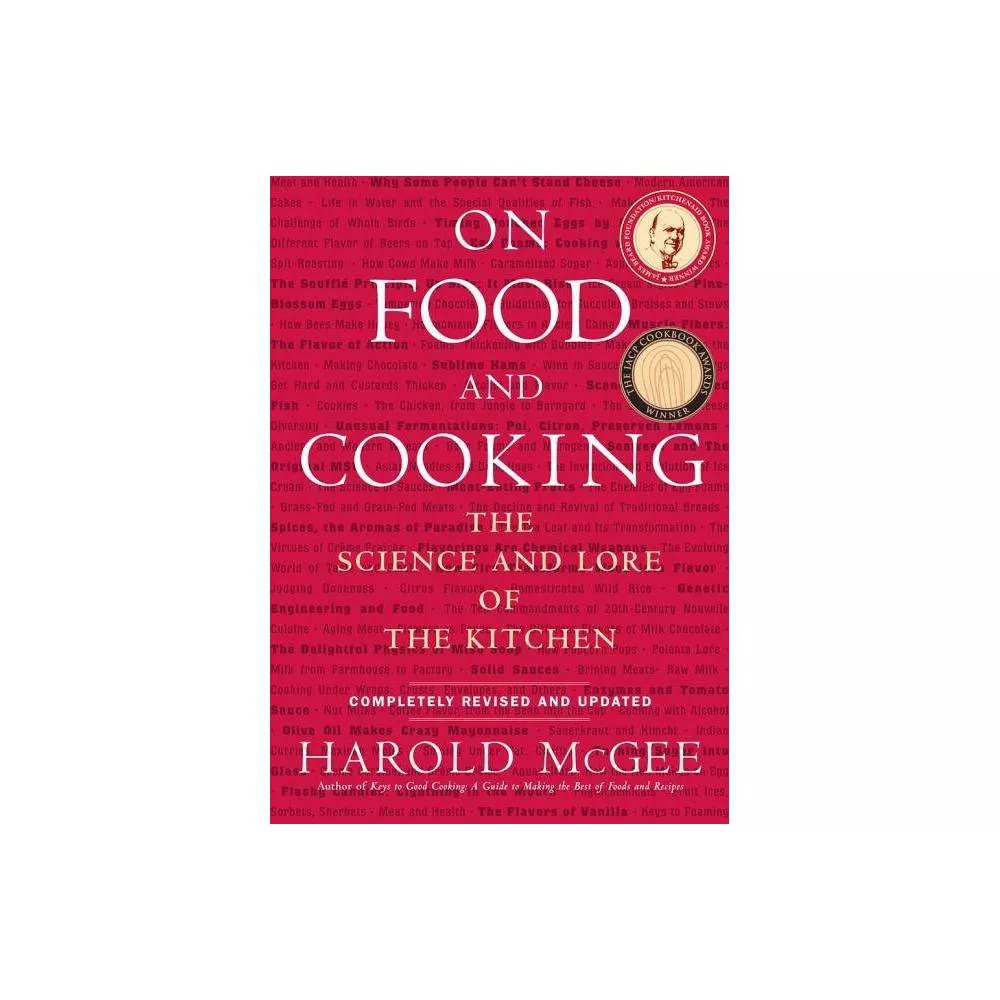
Considered by many as the preeminent resource on food science, Harold McGee’s “On Food and Cooking: The Science and Lore of the Kitchen” is one of the most popular of all food science books. Typically found alongside “Larousse Gastronomique” as a staple on a chef’s bookshelf, particularly when it comes to food science, this book is a whopping 896 pages.
McGee’s book is a true masterpiece of culinary literature. This comprehensive book covers the science of cooking, exploring the chemical and physical properties of food and how they are affected by various cooking methods.
The 15 chapters encompass a range of topics, including but not limited to “Eggs,” “Cereal Doughs and Batters: Bread, Cake, Pastry, Pasta,” “Sugars, Chocolate, and Confectionary,” and “Cooking Methods and Utensil Materials.” McGee explores the science behind cooking techniques like baking, grilling, and frying, as well as the properties of different ingredients like meats, vegetables, and grains.
In 1984, when the book was first published, Time magazine said it was “a minor masterpiece.” Chef Daniel Boulud said, “This book is a treasure trove of useful facts and unusual information and a must for every cook who possesses an inquiring mind.”
What sets “On Food and Cooking” apart is its approachable, engaging writing style. Despite the complex subject matter, McGee presents the information in a way that is easy to understand and digest. He uses real-world examples to illustrate his points, making the science of cooking come alive.
One of the strengths of the book is its emphasis on the importance of understanding the science of cooking. By providing a solid foundation in the chemical and physical properties of food, McGee empowers cooks to experiment and innovate in the kitchen.
In addition to its practical information, “On Food and Cooking” is also a pleasure to read. McGee’s writing is engaging and informative, and the book is filled with interesting anecdotes and historical context.
Overall, “On Food and Cooking” is a must-read for anyone who is passionate about cooking. McGee’s thorough exploration of the science behind cooking will deepen your understanding of the culinary arts and inspire you to experiment and explore in the kitchen. Whether you’re a professional chef or a home cook, this book is an invaluable resource that you’ll return to again and again.
Larousse Gastronomique: The World’s Greatest Culinary Encyclopedia – $115.00
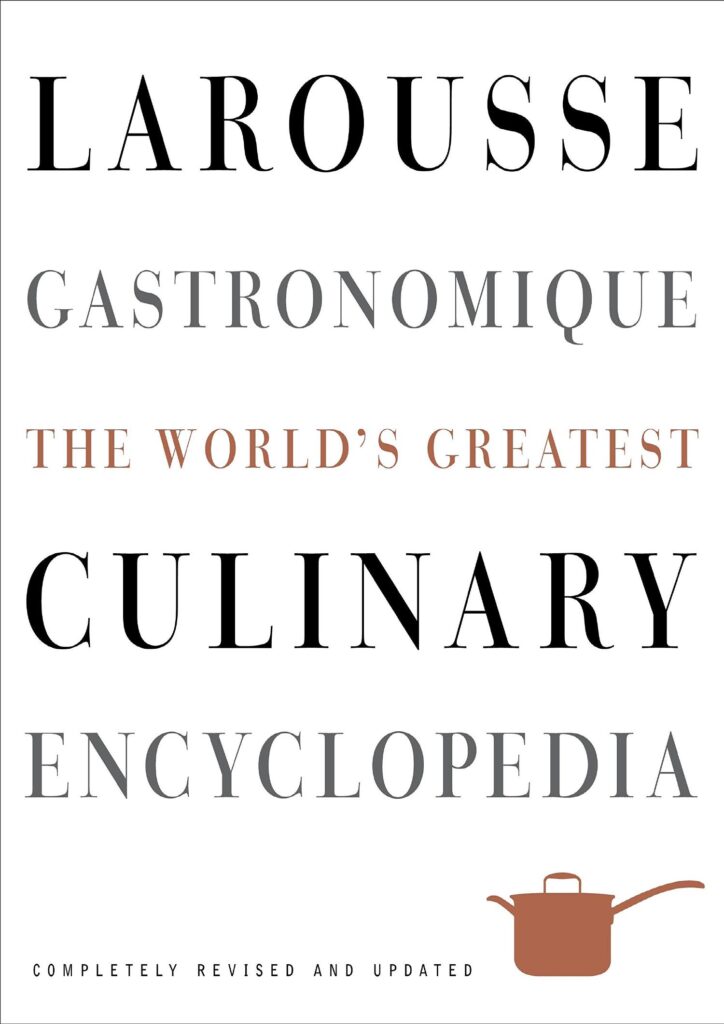
The “Larousse Gastronomique: The World’s Greatest Culinary Encyclopedia” is known as the granddaddy of all food reference books.
Since its first release in 1938, “Larousse Gastronomique” has been the primary authority on culinary expertise. This comprehensive book is highly regarded for its encyclopedic coverage of various topics, including cooking methods, ingredients, recipes, culinary equipment, food histories, and biographies. It is an essential addition to the kitchen bookshelf of both professional chefs and passionate home cooks. Julia Child, the renowned chef, once expressed that if she could have only one reference book in her library, “Larousse Gastronomique” would unquestionably be her choice.
“Larousse Gastronomique” is an indispensable culinary reference book that has stood the test of time. This encyclopedic tome comes in at 1,216 pages and is a treasure trove of culinary knowledge that covers every aspect of cooking, from basic cooking techniques to the history of various foods and ingredients.
What sets this book apart is the depth and breadth of information it provides. Whether you’re a professional chef or an enthusiastic home cook, you will find a wealth of information in this book that will help you improve your cooking skills and broaden your culinary horizons.
One of the book’s strengths is its detailed descriptions of cooking techniques. Whether you’re looking to master the perfect roast, bake a soufflé, or create a classic French sauce, “Larousse Gastronomique” provides step-by-step instructions that are easy to follow and understand.
The book also contains a comprehensive list of ingredients, along with information on their origin, culinary uses, and nutritional value. This information is invaluable for anyone who wants to expand their culinary repertoire and experiment with new ingredients.
In addition to its practical information, “Larousse Gastronomique” is also a fascinating read. The book contains detailed histories of various foods and dishes, along with biographies of famous chefs and culinary figures. These insights into the cultural and historical context of food and cooking add depth and richness to the book’s already impressive content.
Overall, “Larousse Gastronomique” is a must-have for anyone who is serious about cooking. Its encyclopedic coverage, detailed instructions, and fascinating historical context make it an invaluable resource that will inspire and inform cooks of all levels.
How Baking Works: Exploring the Fundamentals of Baking Science – Paula Figoni – $45.00
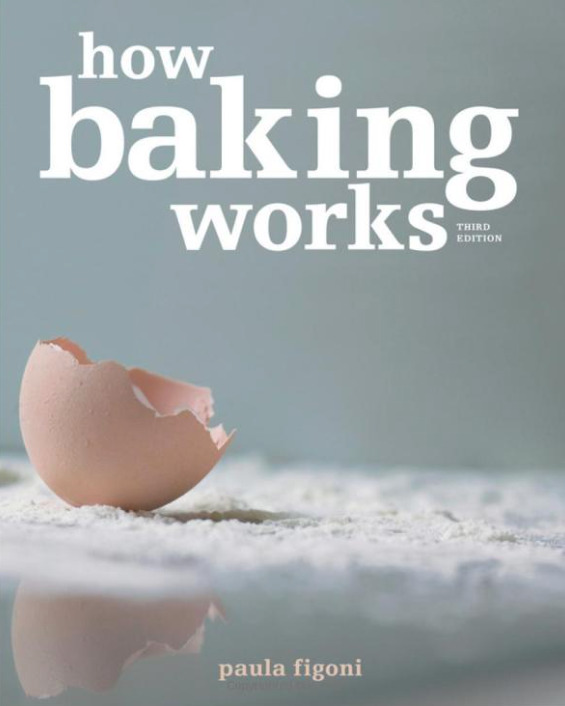
Paula Figoni’s “How Baking Works: Exploring the Fundamentals of Baking Science” is an excellent resource for anyone interested in the science of baking. This comprehensive 516-page book, which is used in some culinary schools, covers everything from the basic chemistry of baking to the principles of recipe development. In fact, it is one of the textbooks that is used in many culinary schools including Johnson & Wales University.
One of the strengths of the book is its approachable writing style. Despite the technical subject matter, Figoni presents the information in a way that is easy to understand and apply. She uses clear, concise language and provides numerous examples and illustrations to help readers grasp the concepts.
The book covers a wide range of topics, from the properties of different ingredients like flour and sugar to the science behind leavening agents like yeast and baking powder. Figoni also explores the effects of temperature, humidity, and altitude on baking, providing practical tips for adjusting recipes to account for these factors.
One of the highlights of the book is the emphasis on the importance of precision in baking. Figoni stresses the need for accurate measurements and timing in order to achieve consistent results, and provides detailed guidance on how to achieve this.
Figoni’s passion for baking shines through in her writing, and the book is filled with interesting anecdotes and historical context.
Overall, “How Baking Works” is an essential resource for anyone who is serious about baking. Figoni’s thorough exploration of the science behind baking will deepen your understanding of this complex art and help you achieve consistently delicious results in the kitchen. Whether you’re a professional pastry chef or a home baker, this book is an invaluable addition to your library.
The Flavor Thesaurus: A Compendium of Pairings, Recipes and Ideas for the Creative Cook – Niki Segnit – $32.00
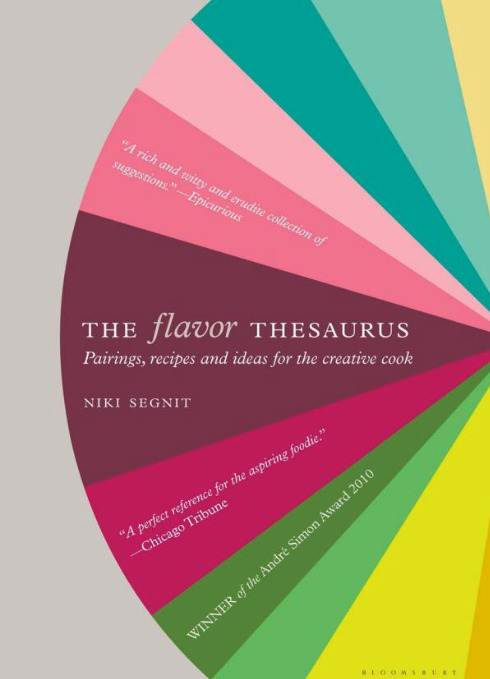
“The Flavor Thesaurus: A Compendium of Parings, Recipes and Ideas for the Creative Cook” by Niki Segnit is a brilliant and comprehensive reference guide for anyone interested in cooking and exploring new flavors. The book is organized into several chapters, each of which focuses on a specific flavor profile or ingredient. Within each chapter, Segnit explores the many different ways that a particular flavor can be used in cooking, as well as the various ingredients that complement and enhance it.
One of the standout features of this book is its ability to provide unique flavor combinations that may not have been initially considered. By incorporating these unexpected pairings into classic recipes, a limitless range of taste and flavor variations can be achieved.
What sets this book apart from other cookbooks and reference guides is its writing style. Segnit is a talented and engaging writer who uses humor, anecdotes, and personal experience to bring the flavors she discusses to life. This makes the book not only informative but also enjoyable to read.
Another standout feature of “The Flavor Thesaurus” is its organization. The book is not simply a list of flavors and their corresponding ingredients, but rather a nuanced exploration of the many different relationships that exist between flavors. Segnit’s approach is both scientific and creative, and she encourages readers to experiment and think outside the box when it comes to flavor pairings.
Overall, “The Flavor Thesaurus” is an invaluable resource for anyone looking to expand their culinary horizons. Whether you’re a professional chef or a home cook, this book will inspire you to try new ingredients, experiment with new flavors, and approach cooking in a more creative and imaginative way. Highly recommended!
Ratio: The Simple Codes Behind the Craft of Everyday Cooking – Michael Ruhlman – $17.00
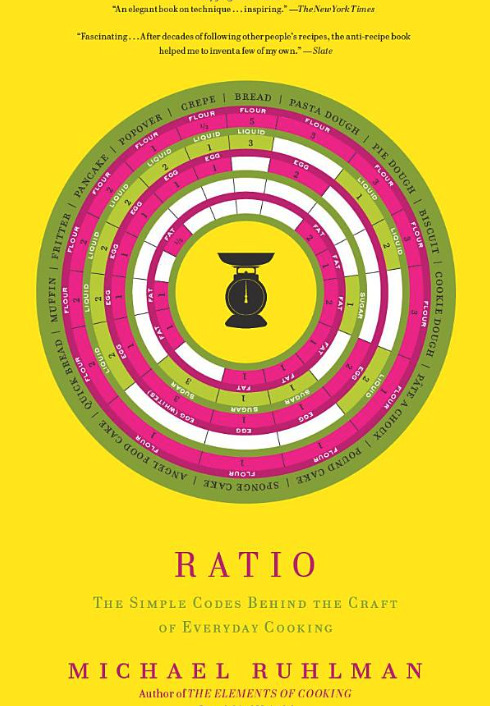
Michael Ruhlman’s book “Ratio: The Simple Codes Behind the Craft of Everyday Cooking” is a game-changer for home cooks. The premise of the book is simple: if you understand the basic ratios behind cooking, you can make virtually any dish without a recipe. Ruhlman’s approach is empowering and liberating, giving home cooks the tools they need to experiment and create in the kitchen.
The book is organized into chapters based on ratio categories, such as doughs, stocks, sauces, and custards. Each chapter starts with a basic ratio (such as 2 parts flour to 1 part liquid for a basic dough) and then provides variations and recipes that use that ratio. Ruhlman’s writing is clear and concise, and he provides helpful tips and tricks throughout the book.
“Ratio” is not just a collection of recipes, but a guide to understanding the fundamentals of cooking. Ruhlman’s approach encourages experimentation and creativity, rather than rigid adherence to recipes. By understanding the ratios behind cooking, readers can make informed decisions about ingredient substitutions, and tailor recipes to their own tastes and preferences.
The recipes in “Ratio” are well-tested and reliable, and range from basic (such as the aforementioned basic dough) to more complex (such as beurre blanc). The book also includes helpful charts and diagrams to aid in understanding the ratios and their applications.
Overall, Ratio is an essential cookbook for anyone who wants to become a better, more confident cook. Ruhlman’s approach is refreshingly simple and straightforward, and the book is a joy to read and use. Whether you’re a beginner or an experienced cook, Ratio will change the way you think about cooking and inspire you to experiment and create in the kitchen.
The Advanced Art of Baking and Pastry – Chef Andy Chlebana – $78.95

While the fact that Chef Andy Chlebana, the coach of Club Coupe du Monde Team USA 2023, wrote “The Advanced Art of Baking and Pastry” might lead one to assume that it is included on our list solely for that reason, we can guarantee that it is actually a valuable reference for baking and pastry.
“The Advanced Art of Baking and Pastry” by Andy Chlebana is an outstanding resource for professional pastry chefs and advanced bakers seeking to refine their skills and techniques.
The 496-page book is divided into sections that cover a range of topics, from pastry basics to advanced decorating techniques. Each section is clearly organized and provides detailed explanations of the necessary ingredients, tools, and techniques required for success.
The book is divided into 14 chapters and covers topics such as Viennoiserie, Cake Mixing and Baking, Plated Desserts, Chocolate Work, and more.
One of the strengths of this book is its emphasis on the science behind baking and pastry-making. Chlebana provides detailed explanations of the chemical reactions that occur during baking and the effects of temperature, humidity, and other factors on the final product. This scientific approach sets this book apart from other baking and pastry cookbooks and provides a deeper understanding of the art of pastry-making.
Another standout feature of this book is its stunning photography. The photographs are not only beautiful, but they also provide clear visual examples of the techniques being discussed. This is especially helpful for more complex techniques, such as sugar work and chocolate decorations.
Overall, “The Advanced Art of Baking and Pastry” is a comprehensive and detailed resource for experienced pastry chefs and advanced bakers looking to improve their craft. The scientific explanations and detailed techniques, combined with stunning photography, make this book a must-have for any serious pastry professional.
The Professional Chef – The Culinary Institute of America – $94.95

“The Professional Chef” from the Culinary Institute of America is an outstanding resource for anyone looking to improve their culinary skills. This comprehensive book covers everything from basic cooking techniques to advanced culinary arts, making it a must-have for professional chefs and home cooks alike.
The book is organized into 10 chapters, each focusing on a specific aspect of cooking. Chapter 1 covers the basics of kitchen equipment and knife skills, while subsequent chapters delve into topics such as stocks, soups, sauces, meats, fish, vegetables, and desserts. Each chapter is well-structured, with clear explanations and step-by-step instructions that are easy to follow.
One of the things that sets “The Professional Chef” apart from other cookbooks is its emphasis on technique. Rather than simply providing recipes, the book teaches readers how to cook by explaining the fundamental principles behind each dish. This approach not only helps readers understand how and why certain ingredients and techniques are used but also allows them to adapt recipes to their own tastes and preferences.
“The Professional Chef” is filled with helpful tips and tricks, such as how to properly sharpen a knife or how to make a smooth and velvety sauce. The authors clearly have a wealth of knowledge and experience, and they are able to convey this information in a way that is both informative and engaging.
Overall, “The Professional Chef” is an exceptional resource for anyone looking to up their culinary game. Whether you are a professional chef or a home cook, this book is sure to become a staple in your kitchen. With its clear explanations, detailed instructions, and emphasis on technique, it is a must-have for anyone who is passionate about cooking.
The Art of the Confectioner: Sugarwork and Pastillage – Chef Ewald Notter – $65.00
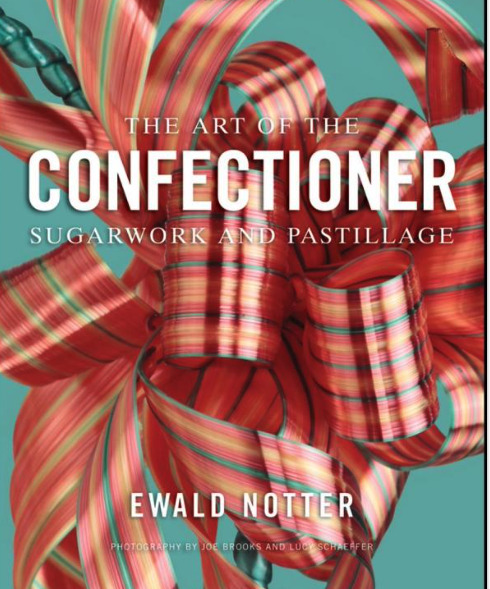
Ewald Notter’s book, “The Art of the Confectioner: Sugarwork and Pastillage,” is a true masterpiece. As a renowned pastry chef and chocolatier, Notter brings his wealth of experience and expertise to the art of sugarwork and pastillage, and this book is a testament to his skill and passion.
With his reputation as one of the finest sugar artists globally, Ewald Notter is in high demand for teaching classes and seminars. He is also one of the chef advisors for Club Coupe du Monde Team USA.
From the very beginning, it’s clear that this is not your average cookbook. In its 368 pages, Notter’s writing is engaging, insightful, and often poetic. He delves into the history and culture of confectionery and shares personal anecdotes and reflections that add depth and richness to the book.
But of course, the heart of the book is the recipes themselves, and they do not disappoint. Notter covers everything from basic sugar pulling techniques to elaborate pastillage sculptures, and every recipe is accompanied by step-by-step instructions and beautiful photography. The level of detail and precision is truly impressive, and readers are sure to come away with a newfound appreciation for the artistry and skill involved in sugarwork and pastillage.
One of the things that sets this book apart is the way that Notter encourages readers to experiment and make each recipe their own. He offers plenty of variations and suggestions for customizing each recipe, and emphasizes the importance of creativity and personal expression in confectionery.
For anyone interested in the art of sugar work and pastillage, “The Art of the Confectioner: Sugarwork and Pastillage” is an essential addition to their collection. Despite some may think that this type of sugar work is becoming outdated, it is quite the opposite. Sugar work remains a crucial skill for those in the hospitality industry and is a must-have talent for those aspiring to join the U.S. Pastry Team and compete in the Coupe du Monde de la Pâtisserie.
Notter’s passion, skill, and creativity shine through on every page, and readers are sure to be inspired and challenged to take their own confectionery skills to the next level.